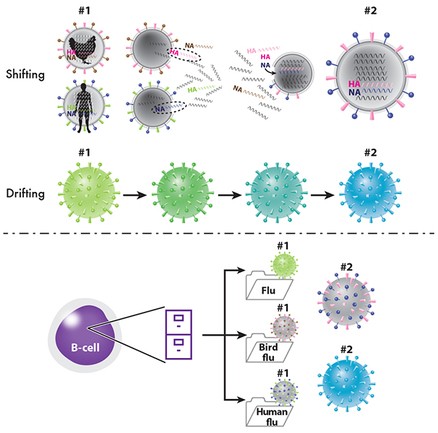The mini pop quiz question from last post was:
What is the difference between antigenic SHIFT and antigenic DRIFT?
The answer is: TIME.
Yes, I gave you a trick question! The fact of the matter is, both mechanisms effect a genetic mutation that leads to a phenotypic change in the resulting flu virus. In the graphic, the viruses labeled #1 are significantly different from the viruses labeled #2. Each genetic change in each mechanism is responsible for an outward change, a new characteristic that makes the progeny virus unique. This is GOOD for the virus, but BAD for our immune system, for if you recall, B-cells are responsible for cataloging previously encountered viruses (see lower half of graphic) and other pathogens. Our immune system works efficiently because of this catalog; the cells that survey our bloodstreams for bad pathogens can more quickly recognize those that have already been encountered and filed away into memory. And the resulting response is so much faster and stronger than for the first encounter.
Both the shifting and the drifting mechanisms can produce entirely “new” virus strains (#2) that are unrecognized by our immune system. It is like encountering an entirely new pathogen, and has to start from scratch in identifying it as “bad.”
Getting back to our pop quiz, while both mechanisms produce the same outcome--a strain of virus that is “new” to our immune system--the genetic mutations produced in shifting occur on a different time scale than in drifting. Antigenic drift may not initially result in a phenotypic shift. In essence, the child virus may be practically identical to that of the parent. But over time, with the accumulation of many mutations over MANY generations of flu (occurs by errors in genetic copying), an entirely new strain of virus can be produced. In antigenic shift, where two viruses that infect the same host may in fact mix up their genetic material, the resulting new viruses may contain some segments from one viral strain and some from the other viral strain. Thus, in ONE generation, a new, unrecognizable, phenotypic viral strain can be created.
Obviously, there are more differences between antigenic shift and drift other than time. I was feeling especially clever when writing this post. Thanks for indulging me!
What is the difference between antigenic SHIFT and antigenic DRIFT?
The answer is: TIME.
Yes, I gave you a trick question! The fact of the matter is, both mechanisms effect a genetic mutation that leads to a phenotypic change in the resulting flu virus. In the graphic, the viruses labeled #1 are significantly different from the viruses labeled #2. Each genetic change in each mechanism is responsible for an outward change, a new characteristic that makes the progeny virus unique. This is GOOD for the virus, but BAD for our immune system, for if you recall, B-cells are responsible for cataloging previously encountered viruses (see lower half of graphic) and other pathogens. Our immune system works efficiently because of this catalog; the cells that survey our bloodstreams for bad pathogens can more quickly recognize those that have already been encountered and filed away into memory. And the resulting response is so much faster and stronger than for the first encounter.
Both the shifting and the drifting mechanisms can produce entirely “new” virus strains (#2) that are unrecognized by our immune system. It is like encountering an entirely new pathogen, and has to start from scratch in identifying it as “bad.”
Getting back to our pop quiz, while both mechanisms produce the same outcome--a strain of virus that is “new” to our immune system--the genetic mutations produced in shifting occur on a different time scale than in drifting. Antigenic drift may not initially result in a phenotypic shift. In essence, the child virus may be practically identical to that of the parent. But over time, with the accumulation of many mutations over MANY generations of flu (occurs by errors in genetic copying), an entirely new strain of virus can be produced. In antigenic shift, where two viruses that infect the same host may in fact mix up their genetic material, the resulting new viruses may contain some segments from one viral strain and some from the other viral strain. Thus, in ONE generation, a new, unrecognizable, phenotypic viral strain can be created.
Obviously, there are more differences between antigenic shift and drift other than time. I was feeling especially clever when writing this post. Thanks for indulging me!


 RSS Feed
RSS Feed
